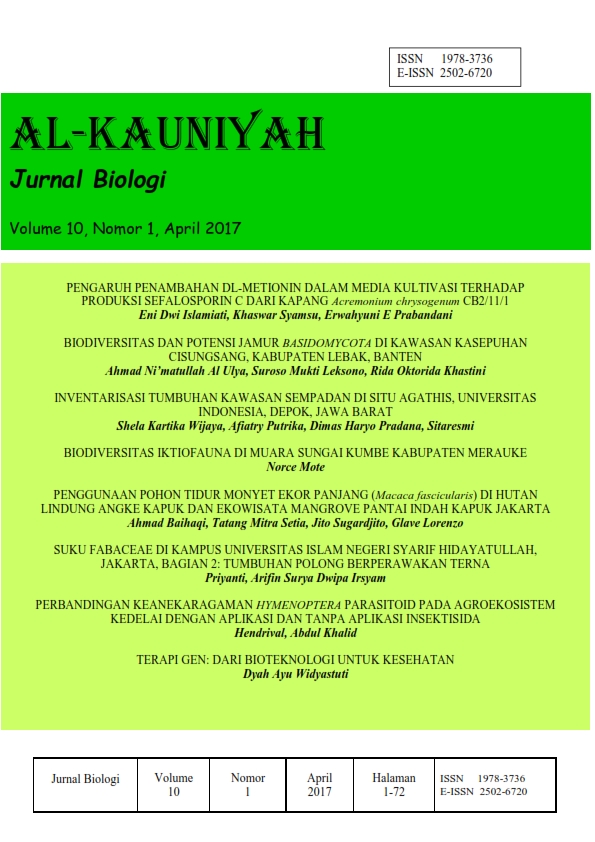SUKU FABACEAE DI KAMPUS UNIVERSITAS ISLAM NEGERI SYARIF HIDAYATULLAH, JAKARTA, BAGIAN 2: TUMBUHAN POLONG BERPERAWAKAN TERNA
DOI:
https://doi.org/10.15408/kauniyah.v10i1.4872Keywords:
Anak suku, Jelajah, Keanekaragaman, Puak, Tumbuhan polong, Legumes, Subfamilies, Survey, TribesAbstract
Abstrak
Suku Fabaceae adalah tetumbuhan yang memiliki buah bertipe polong. Suku tersebut selain berperawakan pohon juga berupa terna. Anggota suku Fabaceae (polong) banyak ditemukan di sekitar lingkungan manusia termasuk di Kampus Universitas Islam Negeri (UIN) Syarif Hidayatullah, Jakarta. Informasi mengenai keanekaragaman tumbuhan polong yang berupa terna di Kampus UIN Syarif Hidayatullah belum tersedia. Penelitian dilakukan menggunakan metode jelajah di kampus I dan II serta studi pustaka. Sebanyak 3 jenis tumbuhan polong berperawakan terna telah didapatkan di lingkungan kampus, yaitu Arachis pintoi Krapov. & W. C. Greg., Mimosa diplotricha C. Wright ex Sauvalle, dan M. pudica L. Jenis-jenis tersebut termasuk ke dalam 2 anak suku (Faboideae, Mimosoideae) dan 2 puak (Aeschynomeneae, Mimoseae). Jenis-jenis tersebut tumbuh di lokasi yang berbeda-beda. Tumbuhan polong yang hanya ditemukan di Fakultas Kedokteran dan Ilmu Keshatan (FKIK) adalah A. pintoi. Mimosa diplotricha ditemukan tumbuh di Pusat Laboratorium Terpadu Fakultas Sains dan Teknologi, Perpustakaan Utama, FKIK, Fakultas Sosial dan Ilmu Politik (FISIP), Wisma Syahida, Pusat Bahasa, dan Sekolah Pascasarjana, sedangkan M. pudica ditemukan Perpustakaan Utama, FISIP, dan Wisma Syahida. Kelengkapan data tentang tumbuhan polong di Kampus UIN Syarif Hidayatullah ini dapat digunakan oleh para mahasiswa untuk mempelajari keanekaragamnnya.
Abstract
Fabaceae is a plant with a pod-type fruit. A Habit of this family is not only trees but also herb. Fabaceae (legumes) is often found on the human environment around campus included in the State Islamic University (UIN) Syarif Hidayatullah, Jakarta. The Information about the legume herbs diversity on the UIN Syarif Hidayatullah yet available. The study was conducted using survey and literature methods. There were 3 species legume herbs in the campus, viz. Arachis pintoi Krapov. & W. C. Greg., Mimosa diplotricha C. Wright ex Sauvalle, and M. pudica L. All species are differentiated into 2 subfamilies (Faboideae, Mimosoideae) and 2 tribes (Aeschynomeneae, Mimoseae). These species grow in the different locations. The Legumes only found at the Faculty of Medical and Health Science (FKIK) is A. pintoi. Mimosa diplotricha found growing around Central of Integrated Laboratory of the Faculty of Science and Technology, Main Library, FKIK, Faculty of Social and Political Sciences (FISIP), Wisma Syahida, Language Center, and Graduate School, while M. pudica found around Main Library, FISIP, and Syahida Inn. Data Completeness about legumes on Campus UIN Syarif Hidayatullah can be used by students to study plant diversity.References
Akbarini, D. (1998). Flora kampus Universitas Padjadjaran Jatinangor: Dikotil (MagnoliaceaeBuxaceae). [Skripsi]. Universitas Padjadjaran.
Angiosperm Phylogeny Group [APG] IV. (2016). An update of the Angiosperm Phylogeny Group classification for the orders and sukues of flowering plants: APG IV. Botanical Journal of the Linnean Society, 181: 1-20. doi:10.1111/boj.12385
Backer, C. A. & Bahkuizen van den Brink, R.C. Jr. (1963). Flora of Java. (vol. 1). (pp. 615, 628). Groningen: P. Noordhoff.
Barbour, M. G., Burk, J. H. & Pitts, W. D. (1987). Terrestrial plant ecology 2nd edition California. Inc. Menlo Park: Benjamin/Cumming Publising Company.
Barneby, R. C. (1987). A Note on Mimosa invisa C. Martius ex colla and M. invisa C. Martius (Mimosaceae). Brittonia 39(1): 49-50. doi:10.2307/2806973
Beentje, H. (2012). The kew plant glossary: An illustrated of plant terms. (pp.5-132). Kew: Royal Botanic Garden.
Clark, R. (2014). Leguminosae (Fabaceae): Papilionoideae. In Utteridge, T. & Bramley, G. (Eds.). The Kew: Tropical plant families identification handbook. (pp. 60-61). Kew: Royal Botanic Garden.
Cook, B. G. (1992). Arachis pintoi Krap. & Greg., nom. nud. In Mannetje, L.'t & Jones, R.M. (Eds.). Plant Resources of South-East Asia No. 4: Forages. (pp. 48-50). Wageningen: Pudoc.
Faisal R., Siregar, E. B. M., & Ana, N. (2013). Inventarisasi gulma pada tegakan tanaman muda eucalyptus spp. http://202.0.107.5/index.php/PFSJ/article/viewFile/3525/1683
Ferguson, J. E. & Loch, D. S. (1999). Arachis pintoi in Australia and Latin America. In Loch, D. S., & Ferguson, J. E (Eds). Forage seed Production. Tropical and Subtropical Species (vol. 2). (pp 427-434). UK: CABI Publishing.
Irsyam, A. S. D. & Priyanti. 2016. Suku Fabaceae di Kampus Universitas Islam Negeri (UIN) Syarif Hidayatullah, Jakarta, Bagian 1: Tumbuhan polong berperawakan pohon. Al Kauniyah Jurnal Biologi, 9(1), 37-43. doi: 10.15408
Langran, X., Dezhao, C., Xiangyun, Z., Puhua, H., Zhi, W., Ren, S.,...Sokoloff, D. D. (2010). Flora of China: Fabaceae. (vol. 10). Beijing: Science Press.
Nahdi, M. S., & Darsikin. (2013). Distribusi dan kemelimpahan spesies tumbuhan bawah pada naungan Pinus merkusii, Acacia auriculiformis, dan Eucalyptus alba di Hutan Gama Giri Mandiri Yogyakarta. Jurnal Natur Indonesia, 16(1), 33-41.
Nahdi, M. S., Marsono, D., Sugandawati, T. M. & Baiquni. (2012). Konservasi ekosistem lahan kritis untuk pemenuhan hak hidup masyarakat (Studi kasus di Imogiri Yogyakarta). Millah, 12(1): 124-142.
Nielsen, I. C. (1992). Flora Malesiana ser. 1. (vol. 11(1): Mimosaceae (Leguminosae-Mimosoideae)). (pp 1-226). Leiden: National Herbarium of the Netherlands.
Rifai, M. A. (2002). Kamus Biologi. Jakarta: Balai Pustaka.
Rugayah, Retnowati, A., Windadri, F. I., & Hidayat, A. (2004). Pengumpulan data taksonomi. In Rugayah, Widjaja, E. A., & Praptiwi (Eds). Pedoman pengumpulan data keanekaragaman flora. Bogor: Puslit-LIPI.
Simpson, M. G. (2010). Plant systematics. California: Elsevier Academic Press.
Sinkaran, K. V. (2015). Mimosa diplothrica: Giant sensitive plant. India: Kerala Forest Research Institute.
Soerjani, M., Kostermans, A. J. G. H., & Tjitrosoepomo, G. (1987). Weeds of rice in Indonesia. Jakarta: Balai Pustaka.
Tjitrosoedirdjo, S. S., Mawardi, I. & Tjitrosoedirdjo, S. (2016). 75 Important invasive plant species in Indonesia. (pp. 44-46). Bogor: SEAMEO BIOTROP.
Tunna, S. T., Ahmed, Q. U., Uddin, A. B. M. H. & Sarker, Md. Z. I. (2014). Weeds as alternative useful medicinal source: Mimosa pudica Linn. on diabetes mellitus and its complications. Advanced Material Research, 995: 49-59. doi: 10.4028.
Vogel, E. F. (1987). Guidelines for the preparation of revisions. In Vogel, E. F (Ed.). Manual of herbarium taxonomy theory and practice. (p. 76). Jakarta: UNESCO.

